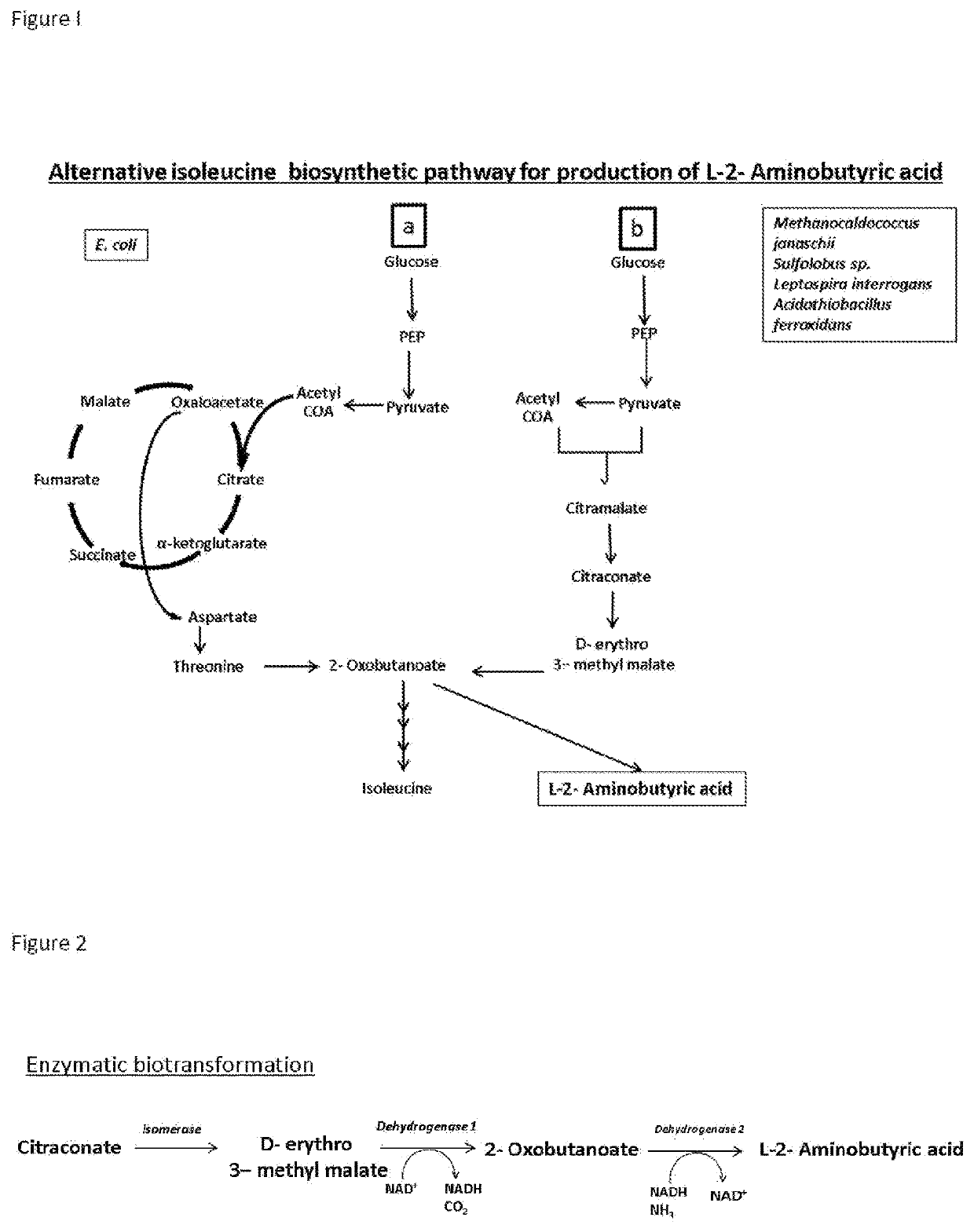Production of l-2-aminobutyrate from citramalate,citraconate or 2-oxobutanoate
a technology of citramalate and citraconate, which is applied in the direction of lyase, transferase, enzymology, etc., can solve the problems of low productivity level of 5 g/l, process becomes cost inefficient, and cannot be desired racemic mixtur
- Summary
- Abstract
- Description
- Claims
- Application Information
AI Technical Summary
Benefits of technology
Problems solved by technology
Method used
Image
Examples
experiment 1
[0078]The enzymatic cell free conversion experiments were set up to convert 10 mM to 2 M citraconate to 10 mM to 2 M L-2-ABA catalyzed by the enzymes, LeuCD, LeuB and ValDH that are either used as crude cell lysate or partially or completely purified.
[0079]The recombinant plasmids carrying the genes namely: pColaDuet-lLeuCD, pETDuet-lLeuB, pETDuet-lValDH were transformed individually into a E. coli. The cells were cultured in complex medium and the enzymes expression was induced by IPTG (Isopropyl-β-D-thiogalactoside). The culturing conditions are provided such that maximum soluble expression of enzymes is obtained. The cells are harvested and lysed to release the enzymes. Either the crude lysate or the purified enzymes are used for the conversion process.
[0080]The conversion of citraconate to L-2-ABA is carried out in a range of pH 7-pH 9. Crude lysate or the purified enzymes are added to the conversion reaction where the other components required for the conversion are present. Le...
experiment 2
[0081]The enzymatic cell free conversion experiments were set up to convert 10 mM to 2 M citraconate to 10 mM to 2 M L-2-ABA catalyzed by the enzymes, LeuCD, LeuB and IlvE that are either used as crude cell lysate or partially or completely purified.
[0082]The recombinant plasmids carrying the genes namely: pColaDuet-lLeuCD, pETDuet-lLeuB, pETDuet-lIlvE were transformed individually into the E. coli or yeast. The cells were cultured in complex medium and the enzymes expression was induced by IPTG. The culturing conditions are provided such that maximum soluble expression of enzymes is obtained. The cells are harvested and lysed to release the enzymes. Either the crude lysate or the purified enzymes are used for the conversion process.
[0083]The conversion of citraconate to L-2-ABA is carried out in a range of pH 7- pH 9. Crude lysate or the purified enzymes are added to the conversion reaction where the other components required for the conversion are present. LeuCD converts citracona...
experiment 3
Biotransformation by Cells Containing Over-Expressed LeuB, LeuCD, ValDH
[0084]L-2-ABA can be produced by whole cell biotransformation from citramalate or citraconate by cells carrying the genes for expressing the three enzymes of the pathway namely LeuCD, LeuB, valDH. The host cell used here is E. coli. The genes were transformed into host cells either as pCOlaDuet-1 BCD valDH or pETDuet-1 CD, pCOlaDuet-1 LeuB valDH. An amount of 1 g to 100 g / L of either citramalate or citraconate is added to the recombinant cells grown in the defined medium containing 5-50 g / L of glucose, KH2PO4, (NH4)2HPO4, Na2EDTA, MgSO4, thiamine HCl, trace metals along with additional ammonia source in the form of ammonium salts. Osmoprotectant such as sorbitol or glycerol may be added to the media for soluble expression of enzymes. Appropriate antibiotics for the particular plasmid and strain were added. Fresh media was changed without MgSO4 during the expression and conversion of substrate. Alternatively, the ...
PUM
| Property | Measurement | Unit |
|---|---|---|
| pH | aaaaa | aaaaa |
| temperature | aaaaa | aaaaa |
| temperature | aaaaa | aaaaa |
Abstract
Description
Claims
Application Information
 Login to View More
Login to View More - R&D
- Intellectual Property
- Life Sciences
- Materials
- Tech Scout
- Unparalleled Data Quality
- Higher Quality Content
- 60% Fewer Hallucinations
Browse by: Latest US Patents, China's latest patents, Technical Efficacy Thesaurus, Application Domain, Technology Topic, Popular Technical Reports.
© 2025 PatSnap. All rights reserved.Legal|Privacy policy|Modern Slavery Act Transparency Statement|Sitemap|About US| Contact US: help@patsnap.com


